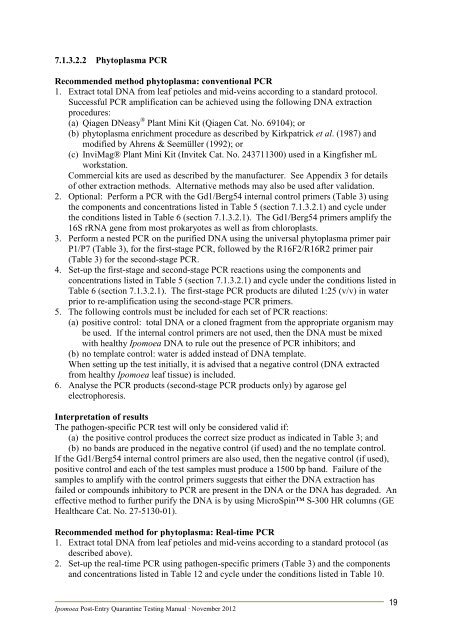Ipomoea (Sweetpotato/Kumara) Post-Entry Quarantine Testing Manual
Ipomoea (Sweetpotato/Kumara) Post-Entry Quarantine Testing Manual
Ipomoea (Sweetpotato/Kumara) Post-Entry Quarantine Testing Manual
You also want an ePaper? Increase the reach of your titles
YUMPU automatically turns print PDFs into web optimized ePapers that Google loves.
7.1.3.2.2 Phytoplasma PCR<br />
Recommended method phytoplasma: conventional PCR<br />
1. Extract total DNA from leaf petioles and mid-veins according to a standard protocol.<br />
Successful PCR amplification can be achieved using the following DNA extraction<br />
procedures:<br />
(a) Qiagen DNeasy ® Plant Mini Kit (Qiagen Cat. No. 69104); or<br />
(b) phytoplasma enrichment procedure as described by Kirkpatrick et al. (1987) and<br />
modified by Ahrens & Seemüller (1992); or<br />
(c) InviMag® Plant Mini Kit (Invitek Cat. No. 243711300) used in a Kingfisher mL<br />
workstation.<br />
Commercial kits are used as described by the manufacturer. See Appendix 3 for details<br />
of other extraction methods. Alternative methods may also be used after validation.<br />
2. Optional: Perform a PCR with the Gd1/Berg54 internal control primers (Table 3) using<br />
the components and concentrations listed in Table 5 (section 7.1.3.2.1) and cycle under<br />
the conditions listed in Table 6 (section 7.1.3.2.1). The Gd1/Berg54 primers amplify the<br />
16S rRNA gene from most prokaryotes as well as from chloroplasts.<br />
3. Perform a nested PCR on the purified DNA using the universal phytoplasma primer pair<br />
P1/P7 (Table 3), for the first-stage PCR, followed by the R16F2/R16R2 primer pair<br />
(Table 3) for the second-stage PCR.<br />
4. Set-up the first-stage and second-stage PCR reactions using the components and<br />
concentrations listed in Table 5 (section 7.1.3.2.1) and cycle under the conditions listed in<br />
Table 6 (section 7.1.3.2.1). The first-stage PCR products are diluted 1:25 (v/v) in water<br />
prior to re-amplification using the second-stage PCR primers.<br />
5. The following controls must be included for each set of PCR reactions:<br />
(a) positive control: total DNA or a cloned fragment from the appropriate organism may<br />
be used. If the internal control primers are not used, then the DNA must be mixed<br />
with healthy <strong>Ipomoea</strong> DNA to rule out the presence of PCR inhibitors; and<br />
(b) no template control: water is added instead of DNA template.<br />
When setting up the test initially, it is advised that a negative control (DNA extracted<br />
from healthy <strong>Ipomoea</strong> leaf tissue) is included.<br />
6. Analyse the PCR products (second-stage PCR products only) by agarose gel<br />
electrophoresis.<br />
Interpretation of results<br />
The pathogen-specific PCR test will only be considered valid if:<br />
(a) the positive control produces the correct size product as indicated in Table 3; and<br />
(b) no bands are produced in the negative control (if used) and the no template control.<br />
If the Gd1/Berg54 internal control primers are also used, then the negative control (if used),<br />
positive control and each of the test samples must produce a 1500 bp band. Failure of the<br />
samples to amplify with the control primers suggests that either the DNA extraction has<br />
failed or compounds inhibitory to PCR are present in the DNA or the DNA has degraded. An<br />
effective method to further purify the DNA is by using MicroSpin S-300 HR columns (GE<br />
Healthcare Cat. No. 27-5130-01).<br />
Recommended method for phytoplasma: Real-time PCR<br />
1. Extract total DNA from leaf petioles and mid-veins according to a standard protocol (as<br />
described above).<br />
2. Set-up the real-time PCR using pathogen-specific primers (Table 3) and the components<br />
and concentrations listed in Table 12 and cycle under the conditions listed in Table 10.<br />
<strong>Ipomoea</strong> <strong>Post</strong>-<strong>Entry</strong> <strong>Quarantine</strong> <strong>Testing</strong> <strong>Manual</strong> · November 2012<br />
19

















